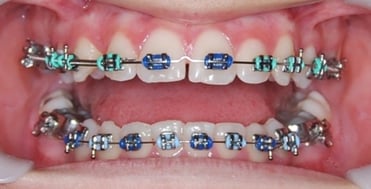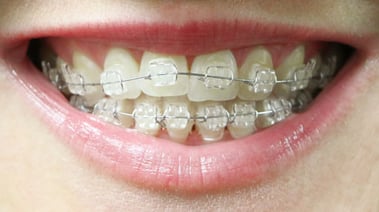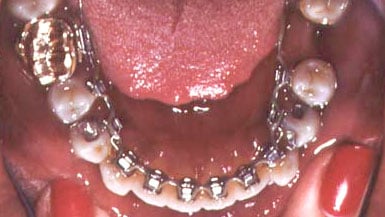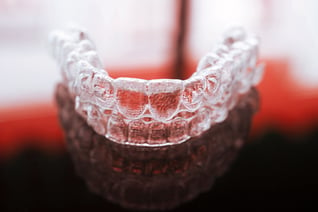We’re going back to the basics because we regularly get asked about appliance philosophy and how it all works. Since many dentists want more working knowledge on appliance design and prescription philosophy we’re going to share some educational information about orthodontic appliances that every dentist should understand. This post is informational and does not intentionally promote any type of orthodontic appliance or brand.
Dental braces are devices that are attached to teeth in order to move them. They are typically connected by metal wires to help align the teeth. In addition to straightening teeth, braces can also be used to improve occlusion, dentofacial balance, alveolar development, and myofunctional health. There are a few types of braces on the market with different designs, advantages and limitations. New inventions typically address the desire to have faster treatment, less visible appliances, predictable results, and higher comfort.
4 Common Types
Metal Braces (Traditional)

This is by far the most common type used as it is typically the cheapest and often most efficient in achieving controlled tooth movement. It includes metal brackets (sometimes also metal bands) and archwires. The bracket is glued to the teeth and a wire fits into the bracket slot to connect them all. Teeth move to the shape of the archwire to straighten the teeth and roots.
There are numerous types of designs and brands of this type. Some popular types of brackets also fall within this category (or clear braces), like self-ligating, tip-edge, and MBT prescription. While there have been some important advances since modern orthodontics’ inception in 1728, many new technologies and features are promoted more for show than actual appliance improvement on cases. Thus, We recommend reviewing peer-reviewed studies and consulting with experienced colleagues when evaluating new bracket systems.
Pros:
- Least cost for doctor and patient
- Typically the fastest as it uses materials based on optimal/efficient tooth movement (not aesthetics)
- Many young patients enjoy having colored rubber bands over their brackets, prevalent on this system. The majority of orthodontic practices comprise of this age group. (The majority of patients in the U.S. and Canada are under 18, although adult treatment continues to grow steadily.)
- Many design and brand choices for clinicians to choose from
- Can be used effectively for all types of orthodontic case types
- You can use skeletal anchorage techniques with this appliance (to control the vertical dimension)
Cons:
- Very visible, which may not be what certain patients want
- Media has portrayed traditional braces as “geeky”, though the stereotype is greatly reduced now
- Numerous amounts of brand and design choices may be overwhelming
- Patients will need to learn new ways to brush and floss to maintain their oral hygiene
Example Brands: IP Appliance (Progressive Dental Supply), Damon (Ormco), BioTru (Great Lakes Orthodontics), Standard Edgewise (American Orthodontics), FASTBRACES Turbo (Orthoworld), Lucid-Lok (Six Month Smiles)
“Clear” Braces

Although it uses a similar design to metal braces, clear braces are a cosmetic alternative as they are less visible to the eye. Instead of metal brackets, these are typically made of ceramic, resin or plastic materials. The materials tend to create more friction during movement and may be more prone to brittleness compared to metal brackets. However, newer ceramic designs have improved in these areas.
Pros:
- Less visible than metal brackets (although you can still see the metal wire)
- Adult orthodontics is one of the fastest growing segments of orthodontic care. According to more recent AAO data, over 1.6 million adults were in active treatment in 2022.
Cons:
- Moderately more costly to the doctor and patient due to higher bracket costs and increased care needed during bonding and treatment.
- More finicky than traditional braces so staff or doctor spends more chair time
- If a bonding error occurs, repositioning a bracket may not be possible depending on the design. Ceramic brackets can be more prone to fracture if removal or rebonding is attempted. you make a bonding error, you need to purchase a new bracket since repositioning isn’t feasible (if the bracket uses wedges to correct tooth rotations)
- Slightly longer treatment time, especially with finishing or if the bracket fractures
- Sometimes need some patient cooperation to not drink soda or other things that may dye the appliance or elastics
Example Brands, most metal braces manufactures also sell “clear” braces: IP Appliance (Progressive Dental Supply), Clarity SL (3-M), Damon Clear (Ormco), Pure Sapphire (Ortho Technology), Discovery Pearl (Dentaurum), Radiance Plus (American Orthodontics)
Lingual Braces

Braces are placed on the lingual side of the teeth and are practically invisible when the patient smiles. Lingual braces can only be spotted when the patient opens his or her mouth. Thus, the material of the braces and wires are typically metal.
Pros:
- Not visible when bite is closed
- Typically adults find this invisibility more aesthetically favorable
- If staining occurs, it will happen lingual of the tooth, so will not be visible
Cons:
- Requires significantly more hand skill and practice by the doctor as less maneuver room
- Significantly more cost to doctor and patient (higher appliance and chair time costs)
- Lingual orthodontics has longer treatment time, since lingually you have shorter distances between teeth and less options for force and anchorage
- May cause issues with speech or discomfort in some patients
- Limited case types can be effectively treated (e.g. no skeletal anchorage)
- Patients with short crowns may not be able to use this type of appliance
- Harder for patient to clean so should not use if patient has periodontic issues
Example Brands: Incognito (3-M), Harmony (American Orthodontics), Suresmile QT (OraMetrix), MTM No Trace (Dentsply), STB Light (Ormco)
Clear Removable Aligners

Although not technically in the braces category (as they aren’t attached to teeth), we wanted to include clear aligners as many clinicians and patients may think they are in a similar category.
A set of multiple clear removable aligners are designed by a lab to have a graduating progression from the shape of a patient’s current bite to the patient’s desired bite. The patient is told to wear it constantly (day and night for at least 22 hours a day), taking it out only during eating, brushing, and flossing. The patient replaces his aligner every two weeks with another slightly closer to their desired bite. Thus, the patient’s teeth move gradually closer to the end result.
Pros:
- Invisible for the most part
- Easy to “sell” as heavy patient marketing from the Invisalign manufacturer has made it popular
- Oral hygiene habits don’t need to change much (as patients can completely remove aligners to brush and floss similarly)
- Can be better for patients with periodontal issues
- Less training needed by dentists to implement as the lab and technology often dictate the appliance design and planning
Cons:
- Requires extremely diligent patient cooperation to get a result
- Longer treatment time
- Significantly more cost to doctor and patient (higher appliance costs range from around $545 to $1645 per case depending on how many arches, case type and amount of trays; this is around 218%-1645% more than most traditional braces)
- More IPR stripping, reducing the natural material of teeth
- Biomechanically inferior than traditional braces (trays have less options for forces and anchorage required for some more complex cases)
- Less appliance control, especially if the doctor relies on the lab to determine the full design (which is common)
- Limited case types can be effectively treated (easy, moderate, and relapse cases usually work well)
- Difficult to achieve major tooth rotations, extrusions, fixing malocclusions, and closing extraction spaces predictably. For example, a study of 37 patients found that the least accurate tooth movement with Invisalign was extrusion (with extrusion of the maxillary being the least at 18.3% accuracy, followed by the mandibular central incisors (24.5%) then mesiodistal tipping of the mandibular canines (26.9%))2.
Example brands: Invisalign (Align Technology), ClearCorrect, MTM Clear Aligner (Dentsply), Simpli5 (Ormco)
As a dentist you should understand the basic differences of these orthodontic appliance types. Patients will ask you for your opinion of how they can get their teeth straightened. Even without full records or a treatment plan, we hope that this will help you diagnose, refer, or plan your practice properly.
References
- New Study Shows Record Number of Adults are Seeking Orthodontic Treatment. American Association of Orthodontists. Accessed Nov 29, 2016.
- Kravitz N, Kusnoto B, BeGole E, Obrez A, Agrane B. A prospective clinical study evaluating the efficacy of tooth movement with Invisalign. American Journal of Orthodontics and Dentofacial Orthopedics 2009; 135:27-35.

